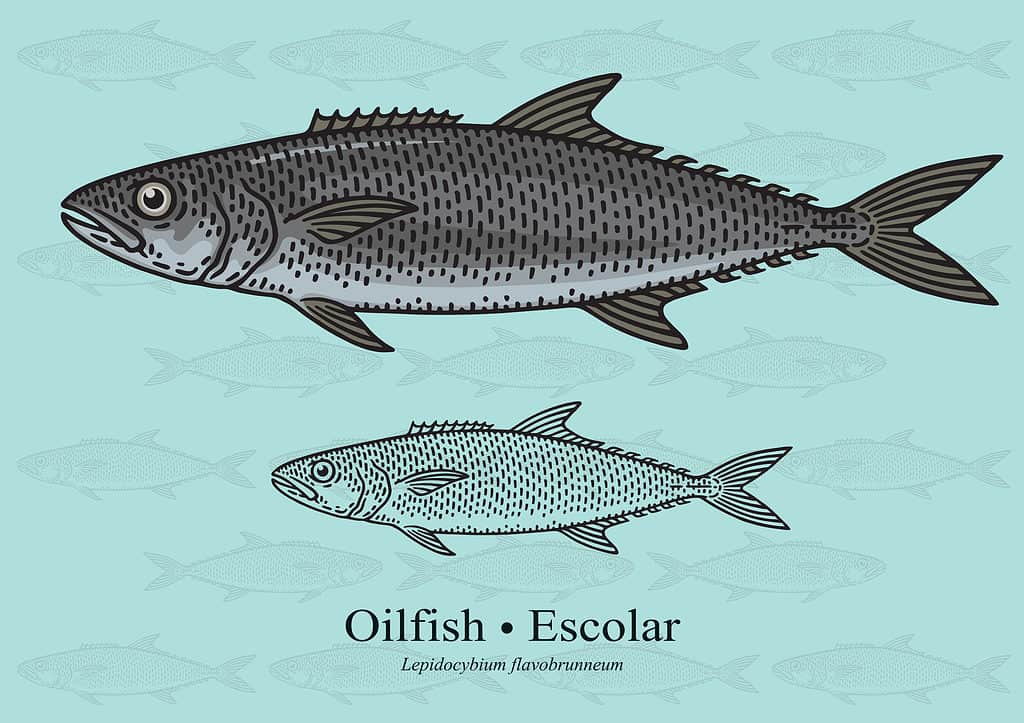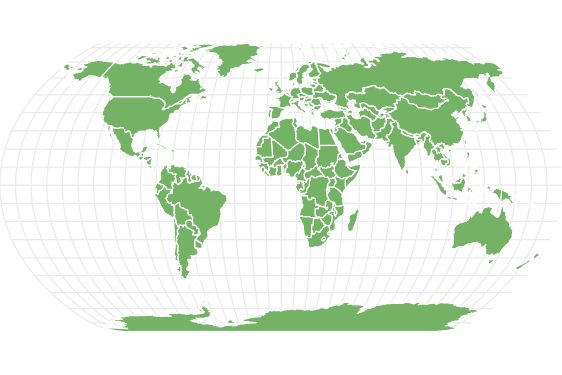Oilfish
Ruvettus pretiosus
They live in deep water as far as 2,600 feet below the water’s surface.
Advertisement
Oilfish Scientific Classification
- Kingdom
- Animalia
- Phylum
- Chordata
- Class
- Actinopterygii
- Order
- Scombriformes
- Family
- Gempylidae
- Genus
- Ruvettus
- Scientific Name
- Ruvettus pretiosus
Read our Complete Guide to Classification of Animals.
Oilfish Conservation Status
Oilfish Facts
- Prey
- squid, small fish, crustaceans
- Group Behavior
- Pair
- Fun Fact
- They live in deep water as far as 2,600 feet below the water’s surface.
- Biggest Threat
- Bycatch from fisheries
- Most Distinctive Feature
- Large eyes, dark-colored scales
- Distinctive Feature
- torpedo-shaped body
- Habitat
- deep water in temperate and tropical water
- Predators
- tuna and marlin
- Diet
- Carnivore
- Type
- Fish
- Common Name
- Oilfish
- Number Of Species
- 1
- Location
- Atlantic Ocean, Pacific Ocean, Mediterranean Sea
View all of the Oilfish images!
“The oilfish is an opportunistic carnivore, eating what is abundant and easy to catch in its environment.”
Summary
The oilfish (Ruvettus pretiosus) is a species of snake mackerel found in the temperate and tropical waters in the Atlantic and Pacific Oceans. They inhabit deep waters, living in pairs and silently swimming through the dark water. It is a popular game fish in certain areas of the world, but many countries have regulations on the importation and sale of its meat. Find out everything there is to know about the oilfish, including where it lives, what it eats, and why you may not want to consume it.
5 Amazing Oilfish Facts
- Oilfish contain high levels of wax esters, which are indigestible to humans.
- Eating oilfish meat can cause symptoms like severe diarrhea, nausea, and vomiting in some people.
- Some fish sellers will mislabel oilfish as cod, causing some countries to ban their importation.
- This species is often bycatch from fisheries, meaning fishermen accidentally catch them.
- They live in deep water as far as 2,600 feet below the water’s surface.
Classification and Scientific Name
The oilfish (Ruvettus pretiosus) belongs to the Actinopterygii class in the Scombriformes order, which encompasses nine families of bony fish. They reside in the Ruvettus family and are known as snake mackerels, and the family includes 25 species. They are the only known member of the Ruvettus genus.
Appearance

Eating oilfish meat can cause symptoms like severe diarrhea, nausea, and vomiting in some people.
©The Fisherman/Shutterstock.com
The oilfish is a snake mackerel fish with a torpedo-shaped body, large eyes, and rough, dark-colored scales. Its body is brown with black fin tips and can grow up to ten feet long, weighing 140 pounds. However, the average oilfish is at most five feet. They look similar to a barracuda and feature fang-like teeth. Their bodies contain mercury and high amounts of oil. The oilfish and the similar fish, escolar, contain around 20% of indigestible wax esters. The fish does not metabolize these esters, and they accumulate in its skin and muscle meat.
Distribution, Population, and Habitat
The oilfish has a cosmopolitan distribution in temperate and tropical waters near the coast in the Atlantic and Pacific Oceans and the Mediterranean Sea. They live in relatively deep waters between 330 and 2,600 feet below the water’s surface. You can find them along the sea floor and water columns.
Predators and Prey
The oilfish is an opportunistic carnivore, eating what is abundant and easy to catch in its environment. Their primary diet includes squid, small fish, and crustaceans. But it will settle for whatever it can swallow. Oilfish have even been recorded eating their way through a whale’s stomach. However, this is a rare occurrence.
Their exact predators are unknown, but they are most likely preyed on by tuna and marlin, like other snake mackerels.
Reproduction and Lifespan
Oilfish are solitary creatures, lurking in deep water alone or in pairs. Not much is known bout their mating habits, except that they reproduce sexually through spawning. Fertilization occurs outside the body, with males releasing their sperm and females their eggs. Spawning occurs during mid to late summer. Their spawn size and lifespan are unknown.
In Fishing and Cooking
Oilfish are edible, but the oil they produce is not digestible by humans. Many countries have advisories or bans against this fish due to the adverse side effects that can occur after eating. Some people can consume oilfish and feel fine, but others experience oily diarrhea, ranging from mild to severe, accompanied by nausea, vomiting, and headaches. The fish’s oil is also not broken down by cooking or freezing.
Because oilfish has a pleasant taste, some fish sellers intentionally mislabel it as butterfish or cod. Due to this deceptive tactic, Japan and Italy have placed import bans on oilfish. The US FDA states that while symptoms may be unpleasant, this species does not pose a serious health risk to the public.
Threats and Conservation Status
The IUCN lists the oilfish as LC or of “least concern.” This species’ population size is stable (without exact figures) and relatively common in its range. While there are no significant threats to the oilfish, they are often bycatch from tuna and swordfish fisheries, which could indirectly impact their population.
Related Animals
View all 66 animals that start with OOilfish FAQs (Frequently Asked Questions)
Are oilfish good eating?
Oilfish have a rich, pleasant flavor, and are a popular game fish in some regions of the world. However, many countries advise you not to eat its meat due to gastrointestinal discomfort.
Why can't you eat oilfish?
Oilfish have high levels of wax esters, which are indigestible in humans. Consuming oilfish can cause severe diarrhea, nausea, vomiting, and headaches.
Where do you catch oilfish?
You can find oilfish in deep water between 300 and 2,600 feet. They live in temperate and tropical waters in the Atlantic and Pacific Oceans and the Mediterranean Sea.
What kind of fish is oilfish?
The oilfish is a species of snake mackerel. And they look similar to a barracuda.
How much oil does an oilfish contain?
The oilfish contains 20% of wax esters. This species also has high levels of mercury.
How big can an oilfish get?
They can grow up to ten feet long and weigh over 140 pounds!
Thank you for reading! Have some feedback for us? Contact the AZ Animals editorial team.
Sources
- , Available here: https://www.cambridge.org/core/journals/journal-of-the-marine-biological-association-of-the-united-kingdom/article/abs/on-the-diet-and-reproduction-of-the-oilfish-ruvettus-pretiosus-perciformes-gempylidae-in-the-eastern-mediterranean/26B69E9E4E6C79279ECD5940778F9AEE
- , Available here: https://www.cfs.gov.hk/english/multimedia/multimedia_pub/multimedia_pub_fsf_07_01.html
- , Available here: https://www.redalyc.org/pdf/5156/515651977009.pdf
- , Available here: https://nsuworks.nova.edu/occ_stuetd/114/
- , Available here: https://www.iucnredlist.org/species/190432/16644022

















